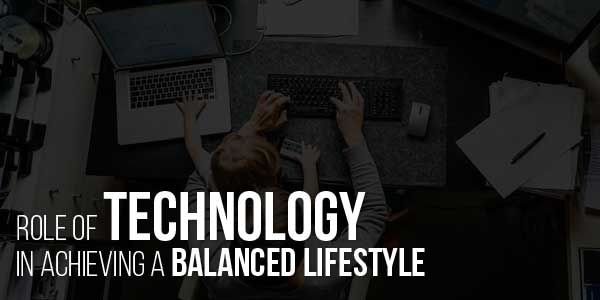
When it comes to a balanced work environment for the employees, especially in a corporate culture. No matter the time of day, they are often met with a barrage of notifications.
While this constant connectivity offers convenience, it may also blur the lines between productivity and burnout. Yet, technology itself may hold the key to reclaiming control–at least, to some extent.
With this blog, we’ll explore the role of technology in achieving a balanced lifestyle. From wellness apps to automation and more, we’ll see how to streamline tasks and enhance well-being for a more sustainable work culture. But first, let’s understand what a balanced lifestyle is.
Table of Contents
What Is A Balanced Lifestyle?
As the term suggests, a balanced lifestyle is where an individual consciously manages their energy and time across key life domains for overall well-being. That includes career, relationships, health, and personal growth.
While it’s not a 50/50 split of hours in a day, this dynamic equilibrium can single area from chronically dominating at the expense of others. That reduces stress, prevents burnout, and fosters long-term fulfilment.
But how can technology help with a balanced lifestyle? Let’s find out.
Role Of Technology In Achieving A Balanced Lifestyle:
Although technology started as a primary source of constant connectivity, you can also use it as a driving force for balance. Beyond being a tool for productivity, technology can help design a more sustainable and fulfilling professional life. Let’s look at its impact on three key areas.
Enforcing Boundaries & Promoting Digital Wellbeing:
Employees can use features like Focus Mode, notification schedulers, and automated “Do Not Disturb” settings to create non-negotiable boundaries, whether at home or at the office. At the office, they can lead away from burnout and at home, they have a genuine mental disconnection after hours.
Enabling Flexibility & Autonomy:
Nowadays, one of the biggest boons of technology is helping employees decouple physical presence from productivity. That is, thanks to cloud-based platforms and seamless video conferencing.
Employees can work effectively from locations that suit their lives, like the comfort of their home. This autonomy over when and where work gets done is a cornerstone of modern work-life balance.
Data-Driven Personal Insights:
Wearables, along with wellness and lifestyle mobile apps, let employees set measurable goals. They can track sleep patterns and activity levels, receiving personalised data to make informed choices about their health.
And employers can leverage aggregated data to identify company-wide stress trends and design better well-being initiatives. So they can create a culture that genuinely supports balance.
Ultimately, when implemented well, employers and employees can integrate work into a healthier, more balanced life.

How To Leverage Technology For A Balanced Lifestyle?
Achieving balance in a digital age requires moving from passive consumption to active management of your technology. The goal is to strategically deploy and leverage tools and technologies that create space for your well-being. Implement these strategies:
Minimal Media Consumption:
Passive scrolling is a major drain on mental energy. Actively use technology to enforce minimalism. You can employ app limiters and notification schedulers (built into iOS and Android).
That way, you can silo your social media and news consumption into defined, short windows. While working, you can also use browser extensions to change infinite scrolls from entertainment feeds into purposeful tools for connection.
Workflow Automation For WFH:
Identify recurring tasks and implement tools like Zapier or IFTTT to connect your apps and automate these workflows. Use calendar blocking tools like Clockwise or Reclaim.ai to automatically find focus time and optimise your meeting schedule. That protects your deep work hours from interruption.
Health Monitoring With Fitness Trackers:
Well-being is often guesswork. Wearable technology provides objective insights to guide your choices. Use your smartwatch or fitness tracker to monitor sleep stages, heart rate variability (HRV), and resting heart rate.
You get a clear view of your stress and recovery levels, which helps prioritize sleep. You can also take a walk between meetings and practice mindfulness to ensure the best results.
Implement Communication Breaks:
Schedule “communication blackout” periods on your shared calendars to signal deep work time. The likes of Slack and Microsoft Teams let you set statuses like “In a focus session, will respond after 3 PM”. That way, you can set clear expectations for sustained focus and reduce cognitive load.
Be Creative With Care Packages:
Balance is nurtured through community and appreciation. Technology can facilitate these human-centric moments through digital gift cards, surprise food deliveries, and even healthy snack box care packages.
It’s a great way to leverage technology for creating moments of genuine recognition and support. You can support and engage the remote employees by strengthening the social bonds.
The most effective leverage comes from consciously choosing technology that supports your values and promptly discarding what drains your time and focus.
So, What’s The Conclusion?
Technology’s role in our pursuit of balance is not inherent; it is assigned. The path to a balanced lifestyle lies in leveraging automation to reclaim time, using data to inform well-being, and setting digital boundaries to protect mental space.
Ultimately, technology achieves its highest purpose not when it helps us do more, but when it empowers us to be more. That is, more present, more healthy, and more in control of our time and energy.

 About the Author:
About the Author:
















Be the first to write a comment.